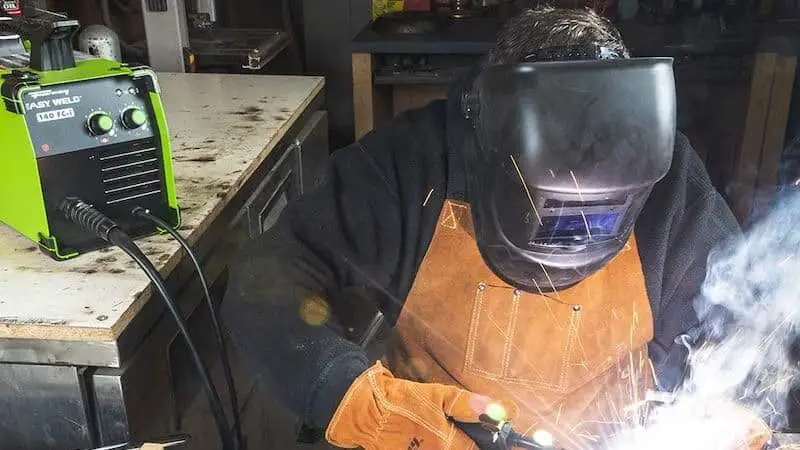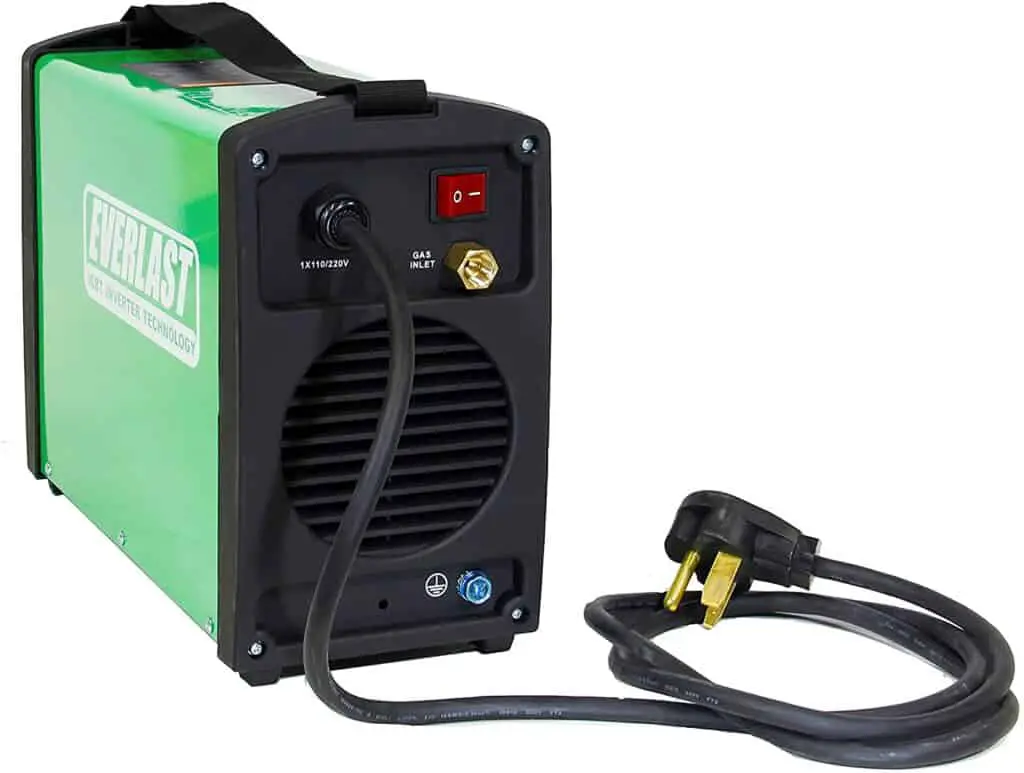Stick welding is a welding technique that is never limited to a single set of people. It is a versatile welding technique and is extremely useful in both industrial and household welding applications.
A 120V stick welder is just perfect for household welding needs as it can be plugged into a conventional power socket in your home.
A 120 volt welder is preferable since it is more compact and less expensive. A 120V stick welder can be used with most outlets, making it relatively portable, which is a significant advantage. They are also ideal for use with a power generator for increased portability.
Here in this article, we have stated several 120v stick welders with all their features along with a comparison chart. But before that, let us see what you need to look for in your 120 volt stick welder.
| Stick Welder | Input voltage | Output (amp) | Duty cycle | Welding thickness | Metals |
|---|---|---|---|---|---|
| KICKINGHORSE A100 | 110V | 100 amps | 30% @ 100 amps | 3/8″ | Mild Steel, cast iron, stainless steel, hard surfacing |
| Miller Electric | 120V | 75 amps | 20% @ 75 amps | 3/8″ | Steel, Iron |
| Forney Easy Arc | 120V | 90 amps | 30% @ 80 amps | 5/16″ | Metal, Steel |
| PowerArc | 240V | 140 amps | 35% @ 160 amps | 1/2″ | Stainless Steel, Steel, Mild steel |
Here are some of the recommended 120V stick welders for you
1.) KICKINGHORSE A100 Stick Welder
- Rated 100A @ 30% duty cycle. Burn 3/16 inch plate in single pass, run 1/8 rod with no stress.
- With 7.7 lb in weight and heavy duty adjustable shoulder strap,
- Extra over-heating, over-voltage and over-load sensors are built-in specifically to address the protection for entry level welders.
- Unbeatable 85V open circuit voltage (OCV) allows A100 very easy to strike the arc. This cutting-edge 40K Hz IGBT inverter has 80% efficiency and cuts energy costs by 25% at least.
Prices pulled from the Amazon Product Advertising API on:
Product prices and availability are accurate as of the date/time indicated and are subject to change. Any price and availability information displayed on [relevant Amazon Site(s), as applicable] at the time of purchase will apply to the purchase of this product.
A power system inverter is used in the construction of this welder. The welder is also small and lightweight, making it perfect for use at home or on the farm.
With a weight of around 7.5 pounds, this welder is one of the lightest sticks currently available on the market.
2.) Miller Electric Stick Welder
- Country of Origin : United States
- Package dimensions : 15.6 L x 13.2 W x 13.3 H
- Package weight : 22.9 Lbs
- Package quantity :1
Prices pulled from the Amazon Product Advertising API on:
Product prices and availability are accurate as of the date/time indicated and are subject to change. Any price and availability information displayed on [relevant Amazon Site(s), as applicable] at the time of purchase will apply to the purchase of this product.
This welder is another excellent welding machine that can be used for a variety of welding operations. This welder is very easy to use, and its compact shape and low weight make it quite portable. This makes it an ideal machine for both novice and professional welders.
3.) Forney Easy Arc Welder
- Inverter power system
- 120 volt input and 90 amp output
- TIG capable (sold separately)
- Handles up to 1/8 inch rod
Prices pulled from the Amazon Product Advertising API on:
Product prices and availability are accurate as of the date/time indicated and are subject to change. Any price and availability information displayed on [relevant Amazon Site(s), as applicable] at the time of purchase will apply to the purchase of this product.
Forney is a well-known brand known for creating high-quality welders. A power system inverter is used in the construction of this welder. The welder is also small and lightweight, making it perfect for use at home or on the farm.
This welder is lightweight and is one of the lightest sticks currently available on the market. It also comes with a 6ft long power cord, which helps to ensure that one can work from any area.
4.) PowerArc Stick Welder
This is a highly popular, well-respected, and commonly used welder, owing to the fact that it is a combination welder that allows you to move back and forth between the ARC and the TIG.
It has a shoulder strap and is quite lightweight, making it incredibly portable and simple to carry around and use wherever you are working.
With the ability to run at 120V or 220V, it is feasible to set up and weld in minutes from any location with a power source.
Things to consider before you purchase a 120 volt stick welder
1.) Brand and quality
The quality of your welder greatly depends on the brand as well. We understand that products from good companies are a little more expensive, but you won’t have to worry about their quality.
You should be able to use the welder you buy for a long period. As a result, it is critical to assess the construction quality.
While the welder’s construction is crucial, so is the construction quality of items like ground clamps, leads, and cables.
While new ones may always be purchased, buying a welder with high-quality wires and clamps will save you money.
2.) Safety Features
Welding is a dangerous job. Working with molten metal is dangerous, as is all that electricity. Therefore, it is always preferable to opt for a machine that will shut down immediately if it starts to overheat.
Low-quality machines may produce uneven arcs, resulting in a lot of metal spray. As a result, it’s not always a good idea to go for affordable welders here. Some qualities are shared by all goods and are considered vital.
Some characteristics, on the other hand, are exclusive to items from distinct brands. You must decide which features you want and which you do not want in your product.
3.) Voltage
The voltage of the welder determines what materials may be welded and how well the connections will be. To start the arc, you’ll need some power, and to melt tougher or thicker materials, you’ll need more power.
So, if you want to perform some modest jobs around the house, a lower voltage welder or a 120 volt stick welder would suffice.
As previously indicated, most 120v welders can handle metal thickness of up to 38 inches. The higher the amperage, the thicker the metal that can be welded. For most domestic usage, an output of 20 to 160 amps will be enough.
4.) Versatility
You should choose a 120 volt stick welder that can handle a variety of applications and chores. Don’t waste your money on a welder that can’t handle diverse jobs or weld different materials.
You of course want to be able to utilise your welder for a variety of welding tasks. This entails selecting a welder that can handle many welding processes.
It should be a decent alternative for folks who wish to perform more than stick welding and also weld steel and aluminum.
5.) Duty Cycle
The duty cycle is just the period of time you can weld before stopping to enable the machine to rest. The entire cycle takes around 10 minutes.
For example, if you have a duty cycle of 30% at 160 amps, this indicates that the machine can work for 3.0 minutes before you consider giving it a rest period of up to 6.5 minutes.
When it comes to duty cycles, the general rule of thumb is that the longer the duty cycle, the better. Most 120v stick welders have a duty cycle of 20 to 30%. This is enough for the majority of homeowners’ requirements. A duty cycle of less than 20% is not optimal.
Welding equipment will overheat due to the electricity flowing through them at some point, and you will need to stop working to enable the unit to cool down.
6.) Portability
One of the advantages of stick welders is their mobility. Moving from one site to another must be simple and quick with multiple welders operating as freelancers.
As a result, it is critical for the welder to select a portable stick welder. Choosing a stick welder that is not easily portable can cause you a slew of issues if you want to move locations.
FAQs-
How much electricity am I going to need for a 120v stick welder?
Stick welders will take a significant quantity of electricity when compared to home equipment. A normal 120v welder will typically take 20 amps of electricity to operate. Check the wiring in your house to ensure that it can handle this quantity of power.
What is the maximum metal thickness that a 120V stick welder can handle?
This will be determined by its maximum output. 120v stick welders, on the other hand, often have a maximum output of no more than 200 amps.
Typically, the range will be between 10 and 180 amps. You should be able to weld up to 38 inch steel and no more than 5/16 inch thick steel with this output.
Conclusion
Because stick welding is one of the oldest welding procedures, most of the previous machines were fairly big and difficult to use.
This is why, back in the day, only skilled welders had access to these welding equipment. Technological advancements have enabled stick welders to be made lighter and easier to use.
And while they do have their limitations, the finest 120v stick welder is a worthwhile purchase for any beginning or intermediate welder.











